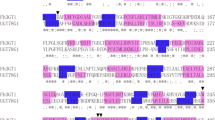Abstract
Polyclonal antibodies were developed against the flavonoid biosynthetic enzymes, CHS, CHI, F3H, FLS, and LDOX from Arabidopsis thaliana. These antibodies were used to perform the first detailed analysis of coordinate expression of flavonoid metabolism at the protein level. The pattern of flavonoid enzyme expression over the course of seedling development was consistent with previous studies indicating that chalcone synthase (CHS), chalcone isomerase (CHI), flavanone 3-hydroxylase (F3H), and flavonol synthase (FLS) are encoded by ‘early’ genes while leucoanthocyanidin dioxygenase (LDOX) is encoded by a ‘late’ gene. This sequential expression may underlie the variations in flavonoid end-products produced during this developmental stage, as determined by HPLC analysis, which includes a shift in the ratio of the flavonols, quercetin and kaempferol. Moreover, immunoblot and HPLC analyses revealed that several transparent testa lines blocked at intermediate steps of the flavonoid pathway actually accumulated higher levels of specific flavonoid enzymes and end-products. These results suggest that specific intermediates may act as inducers of flavonoid metabolism.
Similar content being viewed by others
References
Attridge, T.H., Stewart, G.R. and Smith, H. 1971. End-product inhibition of Pisum phenylalanine ammonia-lyase by the Pisum flavonoids. FEBS Lett. 17: 84–86.
Britsch, L. 1990. Purification of flavanone 3α-hydroxylase from Petunia hybrida: antibody preparation and characterization of a chemogenetically defined mutant. Arch. Biochem. Biophys. 276: 348–354.
Britsch, L., Ruhnau-Brich, B. and Forkmann, G. 1992. Molecular cloning, sequence analysis, and in vitro expression of flavanone 3α-hydroxylase from Petunia hybrida. J. Biol. Chem. 267: 5380–5387.
Burbulis, I.E., Iacobucci, M., Shirley, B.W., 1996. A null mutation in the first enzyme of flavonoid biosynthesis does not affect male fertility in Arabidopsis. Plant Cell 8: 1013–1025.
Cain, C.C., Saslowsky, D.E., Walker, R.A. and Shirley, B.W. 1997. Expression of chalcone synthase and chalcone isomerase proteins in Arabidopsis seedlings. Plant Mol. Biol. 35: 377–381.
Feinbaum, R.L. and Ausubel, F.M. 1988. Transcriptional regulation of the Arabidopsis thaliana chalcone synthase gene. Mol. Cell. Biol. 8: 1985–1992.
Graham, T.L. 1998. Flavonoid and flavonol glycoside metabolism in Arabidopsis. Plant Physiol. Biochem. 36: 135–144.
Hampton, R. and Rine, J. 1994. Regulated degradation of HMGCoA reductase, an integral membrane protein of the endoplasmic reticulum, in yeast. J. Cell Biol. 125: 299–312.
Holton, T.A. and Cornish, E.C. 1995. Genetics and biochemistry of anthocyanin biosynthesis. Plant Cell 7: 1071–1083.
Hrazdina, G., Lifson, E. and Weeden, N.F. 1986. Isolation and characterization of buckwheat (Fagopyrum esculentum M.) chalcone synthase and its polyclonal antibodies. Arch. Biochem. Biophys. 247: 414–419.
Jackson, D., Robert, K. and Martin, C. 1992. Temporal and spatial control of expression of anthocyanin biosynthetic genes in developing flowers of Antirrhinum majus. Plant J. 2: 425–434.
Koes, R.E., Quattrocchio, R. and Mol, J.N.M. 1994. The flavonoid biosynthetic pathway in plants: function and evolution. BioEssays 16: 123–132.
Koornneef, M. 1990. Mutations affecting the testa color in Arabidopsis. Arabidopsis Inf. Serv. 28: 1–4.
Koornneef, M., Luiten, W., de Vlaming, P. and Schram, A.W. 1982. A gene controlling flavonoid-3'-hydroxylation in Arabidopsis. Arabidopsis Inf. Serv. 19: 113–115.
Kubasek, W.L., Shirley, B.W., McKillop, A., Goodman, H.M., Briggs, W. and Ausubel, FM. 1992. Regulation of flavonoid biosynthetic genes in germinating Arabidopsis seedlings. Plant Cell 4: 1229–1236.
Laemmli, U.K. 1970. Cleavage of structural proteins during the assembly of the head of bacteriophage T4. Nature 227: 680–685.
Loake, G.J., Choudhary, A.D., Harrison, M.J., Mavandad, M., Lamb, C.J. and Dixon, R.A. 1991. Phenylpropanoid pathway intermediates regulate transient expression of a chalcone synthase gene promoter. Plant Cell 3: 829–840.
Loake, G.J., Faktor, O., Lamb, C.J. and Dixon, R.A. 1992. Combination of H-box [CCTACC(N)7CT] and G-box (CACGTG) cis elements is necessary for feed-forward stimulation of a chalcone synthase promoter by the phenylpropanoid-pathway intermediate p-coumaric acid. Proc. Natl Acad Sci. USA 89: 9230–9234.
Meyer, K., Cusamano, J.C., Somerville, C., and Chapple, C.S.S. 1996. Ferulate-5-hydroxylase from Arabidopsis thaliana defines a new family of cytochrome P450-dependent monooxygenases. Proc. Natl. Acad. Sci. USA 93: 6869–6874.
Mittal, S., Graham, T.L. and Davis, K.R. 1995. Genetic dissection of the phenylpropanoid pathway in Arabidopsis thaliana. In: D.L. Gunstine and H.E. Flores <nt>(Eds.)</nt>, Phytochemicals and Health, American Society of Plant Physiologists, Rockville, MD, pp. 66–68.
Noh, B. and Spalding, E.P. 1998. Anion channels and the stimulation of anthocyanin accumulation by blue light in Arabidopsis seedlings. Plant Physiol. 116: 503–509.
Pelletier, M.K., Murrell, J., Shirley, B.W. 1997. Arabidopsis flavonol synthase and leucoanthocyanidin dioxygenase: further evidence for distinct regulation of 'early' and 'late' flavonoid biosynthetic genes. Plant Physiol. 113: 1437–1445.
Pelletier, M.K. and Shirley, B.W. 1996. Analysis of flavanone 3-hydroxylase in Arabidopsis seedlings: coordinate regulation with chalcone synthase and chalcone isomerase. Plant Physiol. 111: 339–345.
Pollak, P.E., Vogt, T., Mo, Y. and Taylor, L.P. 1993. Chalcone synthase and flavonol accumulation in stigmas and anthers of Petunia hybrida. Plant Physiol. 102: 925–932.
Shirley, B.W. 1996. Flavonoid biosynthesis: 'new' functions for an 'old' pathway. Trends Plant Sci. 1: 377–382.
Shirley, B.W. 1998. Flavonoids in seeds and grains: physiological function, agronomic importance, and the genetics of biosynthesis. Seed Sci. Res 8: 415–422.
Shirley, B.W., Hanley, S. and Goodman, H.M. 1992. Effects of ionizing radiation on a plant genome: analysis of two Arabidopsis transparent testa mutations. Plant Cell 4: 333–347.
Shirley, B.W., Kubasek, W.L., Storz, G., Bruggemann, E., Koornneef, M., Ausubel, F.M. and Goodman, H.M. 1995. Analysis of Arabidopsis mutants deficient in flavonoid biosynthesis. Plant J. 8: 659–671.
van Tunen, A.J., Mol, J.N. 1987. A novel purification procedure for chalcone flavanone isomerase from Petunia hybrida and the use of its antibodies to characterize the Po mutation. Arch. Biochem. Biophys. 257: 85–91.
Author information
Authors and Affiliations
Rights and permissions
About this article
Cite this article
Pelletier, M.K., Burbulis, I.E. & Winkel-Shirley, B. Disruption of specific flavonoid genes enhances the accumulation of flavonoid enzymes and end-products in Arabidopsis seedlings. Plant Mol Biol 40, 45–54 (1999). https://doi.org/10.1023/A:1026414301100
Issue Date:
DOI: https://doi.org/10.1023/A:1026414301100




